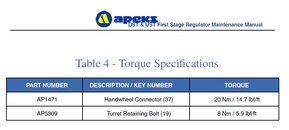To the OP:
While all this torque talk is fascinating and all, I will try to add something different that might be of interest. When you get the Mk25 changed to DIN (torqued or not) you might look at getting a DIN adapter to put on the yoke you pulled off. I have all my Mk25's set up as DIN for cave diving but keep the yoke adapter in my OW vest so any time I am diving AL tanks I just pull it out and slap it on. That way there is no chance of forgeting it and I am always able to dive any tank.
While all this torque talk is fascinating and all, I will try to add something different that might be of interest. When you get the Mk25 changed to DIN (torqued or not) you might look at getting a DIN adapter to put on the yoke you pulled off. I have all my Mk25's set up as DIN for cave diving but keep the yoke adapter in my OW vest so any time I am diving AL tanks I just pull it out and slap it on. That way there is no chance of forgeting it and I am always able to dive any tank.





